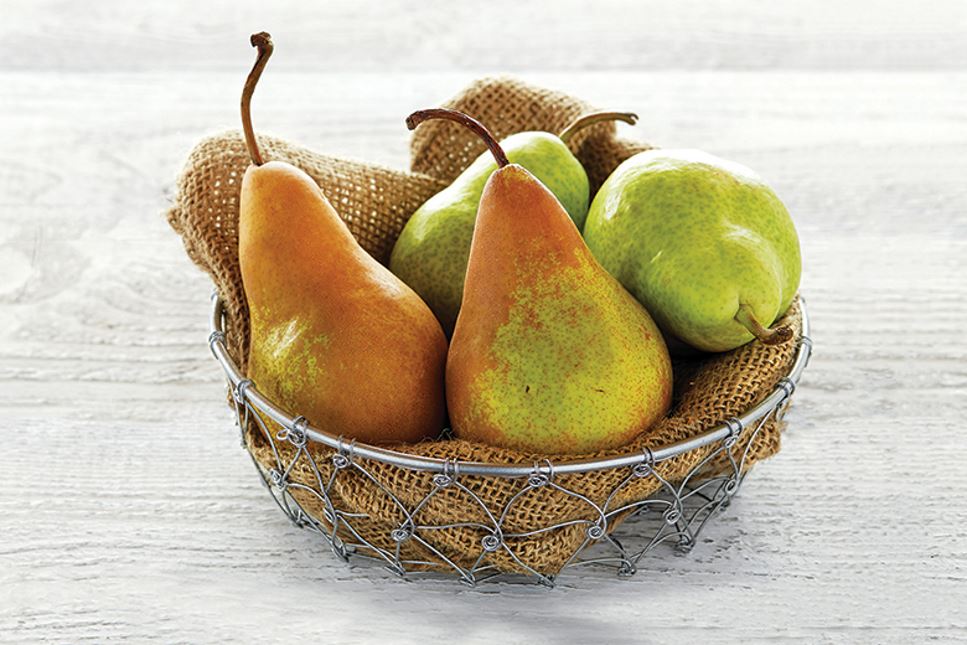A member of the rose family, pears are delicious in both sweet and savory dishes, and can be enjoyed raw, stewed, sautéed, baked, roasted, poached and grilled. Their high pectin content makes pears ideal for jams and spreads.
Nutritionally Speaking
Often compared nutritionally to apples, pears hold their own. At about 100 calories, one medium pear delivers 5.5 grams of dietary fiber and 8% of the Daily Value of vitamin C.
Few studies have specifically examined consuming pears and health outcomes. Most research has grouped apples and pears together since they are similar in nutrient composition. Studies looking at pear and apple consumption have indicated there may be an association with lowered risk of diabetes and stroke.
Growing
The Pacific Northwest produces more than 80% of the nation’s pears.
Availability
While peak pear season is during the fall and winter months, many varieties are available throughout the year.
Purchasing
Pears can be purchased fresh or canned. Pears don’t ripen on the tree, so the pears you buy at the grocery store need to be left at room temperature to ripen and reach peak flavor. Don’t buy pears that are soft anywhere but the neck of the pear (a yield to gentle pressure at the neck, where the stem attaches to the fruit, means the pear is ripe). Pears that are soft anywhere else means they are overripe and mushy. If you plan to eat a pear in a few days, choose one with a neck that is hard.
Storing
Don’t refrigerate unripe pears — they only ripen at room temperature. If you want to speed up ripening, place pears in a paper bag with a ripe banana or apple. These fruits give off ethylene gas, which the pears absorb and then produce on their own, speeding up the ripening process.
Once ripe, pears can be refrigerated until you’re ready to use them. But be aware that while refrigeration will delay further ripening, it won’t stop it completely. Since fresh pears tend to absorb odors, store them away from foods like onions.
Preparing
A ripe pear is delicious on its own or used in recipes. As with other fruits, the flesh of peeled or cut pears will eventually brown, although this natural oxidation won’t change the pear’s quality or taste. To prevent browning, dip cut pears in a solution of half water and half lemon juice, or sprinkle with a commercial citric acid powder.
Using
Anjou pears are the most abundant and can be green with a sweet, almost citrus flavor, or red with a sweeter, slightly spicy flavor. Enjoy Anjou pears fresh, as a chutney or in pie. Available almost year-round, Bartletts deliver classic pear flavor and are great for canning or puréeing. The firm texture and bold flavor of Bosc pears make them best for poaching or baking. Luscious Comice pears are coveted for their creamy texture, succulent sweetness and exceptional juiciness. Also known as the Christmas pear, Comices are best eaten raw, especially paired with cheese. Sweet, petite Seckels are perfect pears for snacking and make an adorable addition to lunch boxes.
Flavors that complement this versatile fruit include warm spices such as allspice, ginger, cardamom, cinnamon, cloves and nutmeg; nuts such as pistachios, almonds and pecans; and dark chocolate.
Pear butter or spiced pear muffins are breakfast favorites. Poach fresh whole pears in wine for a simple dessert or make a pear tart. Use a food processor to julienne pears for a crunchy slaw. Pears also go well with greens; toss them with bitter endive or try a roasted pear, Gorgonzola and pecan salad.
If you end up with too many overripe pears, you can still use them. Blend them into smoothies or sauces. You can freeze pureed pears for future use, too.
This information originally appeared in Food & Nutrition Magazine®, published by the Academy of Nutrition and Dietetics.
References
Find a Nutrition Expert
Looking for credible nutrition information and recommendations? The Academy of Nutrition and Dietetics' network of credentialed food and nutrition practitioners are ready to help!

